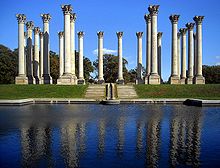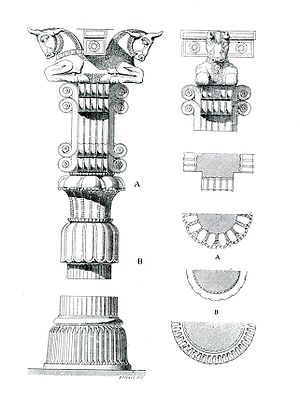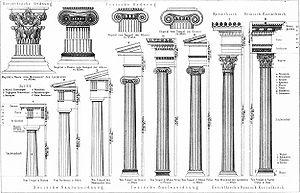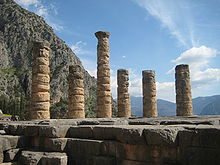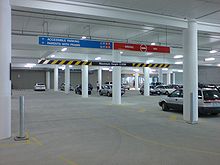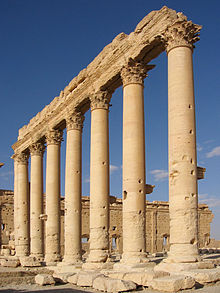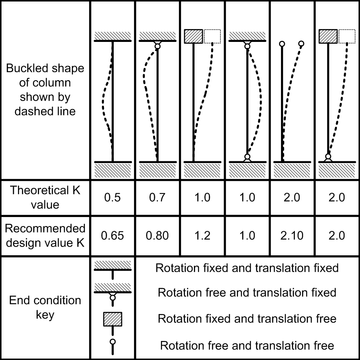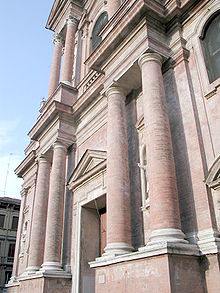- Column
-
For other uses, see Column (disambiguation).
 Marble columns with antique capitals in the Great Mosque of Kairouan also known as the Mosque of Uqba, city of Kairouan, Tunisia
Marble columns with antique capitals in the Great Mosque of Kairouan also known as the Mosque of Uqba, city of Kairouan, Tunisia
A column or pillar in architecture and structural engineering is a vertical structural element that transmits, through compression, the weight of the structure above to other structural elements below. For the purpose of wind or earthquake engineering, columns may be designed to resist lateral forces. Other compression members are often termed "columns" because of the similar stress conditions. Columns are frequently used to support beams or arches on which the upper parts of walls or ceilings rest. In architecture, "column" refers to such a structural element that also has certain proportional and decorative features. A column might also be a decorative element not needed for structural purposes; many columns are "engaged with", that is to say form part of a wall.
Contents
History
All significant Iron Age civilizations of the Near East and Mediterranean made some use of columns. In Ancient Egyptian architecture as early as 2600 BC the architect Imhotep made use of stone columns whose surface was carved to reflect the organic form of bundled reeds; in later Egyptian architecture faceted cylinders were also common.
Some of the most elaborate columns in the ancient world were those of the Persians, especially the massive stone columns erected in Persepolis. They included double-bull structures in their capitals. The Hall of Hundred Columns at Persepolis, measuring 70 × 70 metres, was built by the Achaemenid king Darius I (524–486 BC). Many of the ancient Persian columns are standing, some being more than 30 metres tall.[citation needed]
The Egyptians, Persians and other civilizations mostly used columns for the practical purpose of holding up the roof inside a building, preferring outside walls to be decorated with reliefs or painting, but the Ancient Greeks, followed by the Romans, loved to use them on the outside as well, and the extensive use of columns on the interior and exterior of buildings is one of the most characteristic features of classical architecture, in buildings like the Parthenon. The Greeks developed the classical orders of architecture, which are most easily distinguished by the form of the column and its various elements. Their Doric, Ionic, and Corinthian orders were expanded by the Romans to include the Tuscan and Composite orders (see below).
Columns, or at least large structural exterior ones, became much less significant in the architecture of the Middle Ages, and the classical forms were abandoned in both Byzantine architecture and the Romanesque and Gothic architecture or Europe in favour of more flexible forms, with capitals often using various types of foliage decoration, and in the West scenes with figures carved in relief. Renaissance architecture was keen to revive the classical vocabulary and styles, and the informed use and variation of the classical orders remained fundamental to the training of architects throughout Baroque, Rococo and Neo-classical architecture.
Structure
Early columns were constructed of stone, some out of a single piece of stone. Monolithic columns are among the heaviest stones used in architecture. Other stone columns are created out of multiple sections of stone, mortared or dry-fit together. In many classical sites, sectioned columns were carved with a centre hole or depression so that they could be pegged together, using stone or metal pins. The design of most classical columns incorporates entasis (the inclusion of a slight outward curve in the sides) plus a reduction in diameter along the height of the column, so that the top is as little as 83% of the bottom diameter. This reduction mimics the parallax effects which the eye expects to see, and tends to make columns look taller and straighter than they are while entasis adds to that effect.
Modern columns are constructed out of steel, poured or precast concrete, or brick. They may then be clad in an architectural covering (or veneer), or left bare. In modern terms, the impost (or pier) is the topmost member of a column. The bottom-most part of the arch, called the springing, rests on the impost.
Equilibrium, instability, and loads
Main article: Buckling#columnsMaterials failure modes Buckling · Corrosion · Creep · Fatigue ·
Fouling · Fracture · Hydrogen embrittlement ·
Impact · Mechanical overload ·
Stress corrosion cracking · Thermal shock · Wear · YieldingAs the axial load on a perfectly straight slender column with elastic material properties is increased in magnitude, this ideal column passes through three states: stable equilibrium, neutral equilibrium, and instability. The straight column under load is in stable equilibrium if a lateral force, applied between the two ends of the column, produces a small lateral deflection which disappears and the column returns to its straight form when the lateral force is removed. If the column load is gradually increased, a condition is reached in which the straight form of equilibrium becomes so-called neutral equilibrium, and a small lateral force will produce a deflection that does not disappear and the column remains in this slightly bent form when the lateral force is removed. The load at which neutral equilibrium of a column is reached is called the critical or buckling load. The state of instability is reached when a slight increase of the column load causes uncontrollably growing lateral deflections leading to complete collapse.
For an axially loaded straight column with any end support conditions, the equation of static equilibrium, in the form of a differential equation, can be solved for the deflected shape and critical load of the column. With hinged, fixed or free end support conditions the deflected shape in neutral equilibrium of an initially straight column with uniform cross section throughout its length always follows a partial or composite sinusoidal curve shape, and the critical load is given by

where E = elastic modulus of the material, Imin = the minimal moment of inertia of the cross section, and L = actual length of the column between its two end supports. A variant of (1) is given by

where r = radius of gyration of [column]cross-section which is equal to the square root of (I/A), K = ratio of the longest half sine wave to the actual column length, and KL = effective length (length of an equivalent hinged-hinged column). From Equation (2) it can be noted that the buckling strength of a column is inversely proportional to the square of its length.
When the critical stress, Fcr (Fcr =Pcr/A, where A = cross-sectional area of the column), is greater than the proportional limit of the material, the column is experiencing inelastic buckling. Since at this stress the slope of the material's stress-strain curve, Et (called the tangent modulus), is smaller than that below the proportional limit, the critical load at inelastic buckling is reduced. More complex formulas and procedures apply for such cases, but in its simplest form the critical buckling load formula is given as Equation (3),

where Et = tangent modulus at the stress Fcr
A column with a cross section that lacks symmetry may suffer torsional buckling (sudden twisting) before, or in combination with, lateral buckling. The presence of the twisting deformations renders both theoretical analyses and practical designs rather complex.
Eccentricity of the load, or imperfections such as initial crookedness, decreases column strength. If the axial load on the column is not concentric, that is, its line of action is not precisely coincident with the centroidal axis of the column, the column is characterized as eccentrically loaded. The eccentricity of the load, or an initial curvature, subjects the column to immediate bending. The increased stresses due to the combined axial-plus-flexural stresses result in a reduced load-carrying ability.
Column elements are considered to be massive if minimal side dimension is equal or more than 400 mm. Massive columns have ability to increase concrete strength during long time period (even during exploitation period). Taking into account possible loads onto structure increase in future (and even threat of progressive failure - terroristic attacks, explosions etc.) - massive columns have advantage comparing with not ones. A little economy today has no sense as usual for future. Moreover relatively small sections are not technological for reinforced structures during their production. Balance between economy, mass of structures and so called "sustainable" construction is necessary.
Extensions
When a column is too long to be built or transported in one piece, it has to be extended or spliced at the construction site. A reinforced concrete column is extended by having the steel reinforcing bars protrude a few inches or feet above the top of the concrete, then placing the next level of reinforcing bars to overlap, and pouring the concrete of the next level. A steel column is extended by welding or bolting splice plates on the flanges and webs or walls of the columns to provide a few inches or feet of load transfer from the upper to the lower column section. A timber column is usually extended by the use of a steel tube or wrapped-around sheet-metal plate bolted onto the two connecting timber sections.
when e<12 then it is known as short column
Foundations
A column that carries the load down to a foundation must have means to transfer the load without overstressing the foundation material. Reinforced concrete and masonry columns are generally built directly on top of concrete foundations. A steel column, when seated on a concrete foundation, must have a base plate to spread the load over a larger area and thereby reduce the bearing pressure. The base plate is a thick rectangular steel plate usually welded to the bottom end of the column.
Classical orders
Main article: Classical orderThe Roman author Vitruvius, relying on the writings (now lost) of Greek authors, tells us that the ancient Greeks believed that their Doric order developed from techniques for building in wood in which the earlier smoothed tree trunk was replaced by a stone cylinder.
Doric order
Main article: Doric orderThe Doric order is the oldest and simplest of the classical orders. It is composed of a vertical cylinder that is wider at the bottom. It generally has neither a base nor a detailed capital. It is instead often topped with an inverted frustum of a shallow cone or a cylindrical band of carvings. It is often referred to as the masculine order because it is represented in the bottom level of the Colosseum and the Parthenon, and was therefore considered to be able to hold more weight. The height-to-thickness ratio is about 8:1. The shaft of a Doric Column is always fluted.
The Greek Doric, developed in the western Dorian region of Greece, is the heaviest and most massive of the orders. It rises from the stylobate without any base; it is from four to six times as tall as its diameter; it has twenty broad flutes; the capital consists simply of a banded necking swelling out into a smooth echinus, which carries a flat square abacus; the Doric entablature is also the heaviest, being about one-fourth the height column. The Greek Doric order was not used after c. 100 B.C. until its “rediscovery” in the mid-eighteenth century.
Tuscan order
Main article: Tuscan orderThe Tuscan order, also known as Roman Doric, is also a simple design, the base and capital both being series of cylindrical disks of alternating diameter. The shaft is almost never fluted. The proportions vary, but are generally similar to Doric columns. Height to width ratio is about 7:1.
Ionic order
Main article: Ionic orderThe Ionic column is considerably more complex than the Doric or Tuscan. It usually has a base and the shaft is often fluted (it has grooves carved up its length). On the top is a capital in the characteristic shape of a scroll, called a volute, or scroll, at the four corners. The height-to-thickness ratio is around 9:1. Due to the more refined proportions and scroll capitals, the Ionic column is sometimes associated with academic buildings. Ionic style columns were used on the second level of the Colosseum.
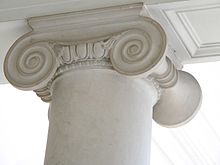 Ionic capital
Ionic capital
Corinthian order
Main article: Corinthian orderThe Corinthian order is named for the Greek city-state of Corinth, to which it was connected in the period. However, according to the architectural historian Vitruvius, the column was created by the sculptor Callimachus, probably an Athenian, who drew acanthus leaves growing around a votive basket. In fact, the oldest known Corinthian capital was found in Bassae, dated at 427 BC. It is sometimes called the feminine order because it is on the top level of the Colosseum and holding up the least weight, and also has the slenderest ratio of thickness to height. Height to width ratio is about 10:1.
Composite order
The Composite order draws its name from the capital being a composite of the Ionic and Corinthian capitals. The acanthus of the Corinthian column already has a scroll-like element, so the distinction is sometimes subtle. Generally the Composite is similar to the Corinthian in proportion and employment, often in the upper tiers of colonnades. Height to width ratio is about 11:1 or 12:1.
Solomonic
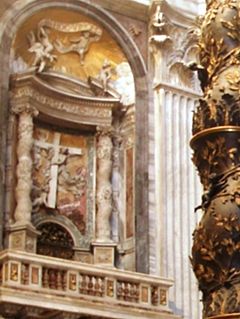 Two of Constantine's Solomonic columns in their present day location on a pier in St Peter's, Rome. Part of Bernini's Baldachin, inspired by the original columns, is in the foreground.
Two of Constantine's Solomonic columns in their present day location on a pier in St Peter's, Rome. Part of Bernini's Baldachin, inspired by the original columns, is in the foreground.
A Solomonic column, sometimes called "barley sugar", begins on a base and ends in a capital, which may be of any order, but the shaft twists in a tight spiral, producing a dramatic, serpentine effect of movement. Solomonic columns were developed in the ancient world, but remained rare there. A famous marble set, probably 2nd century, was brought to St Peter's, Rome by Constantine I, and placed round the saint's shrine, and was thus familiar throughout the Middle Ages, by which time they were thought to have been removed from the Temple of Jerusalem.[1] The style was used in bronze by Bernini for his spectacular St. Peter's baldachin, actually a ciborium (which displaced Constantine's columns), and thereafter became very popular with Baroque and Rococo church architects, above all in Latin America, where they were very often used, especially on a small scale, as they are easy to produce in wood by turning on a lathe (hence also the style's popularity for spindles on furniture and stairs).
Notable columns
- Alexander Column
- Ashoka Column
- Berlin victory column
- Holy Trinity Column in Olomouc
- Iron Column
- Monument to the Great Fire of London
- Nelson's Column
- Rostral Columns
- Saga Column
- San Jacinto Monument
- Sigismund's Column
- Trajan's Column
- Brock's Monument
- Trenton Battle Monument
See also
- Buckling
- Capital
- Colonnade
- Entasis
- Huabiao
- Marian and Holy Trinity columns
- Persian column
- Pier (architecture)
- Pilaster
- Spur (architecture)
- Stanchion
References
- ^ J. Ward-Perkins, "The shrine of St. Peter's and its twelve spiral columns" Journal of Roman Studies 42 (1952) p 21ff.
Categories:- Columns and entablature
- Egyptian artefact types
- Architectural elements
- Structural system
- Earthquake engineering
Wikimedia Foundation. 2010.

